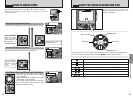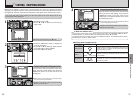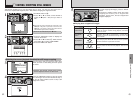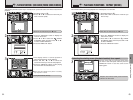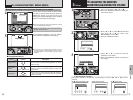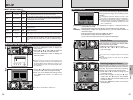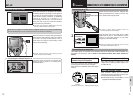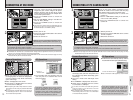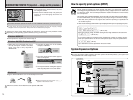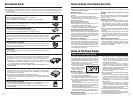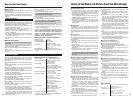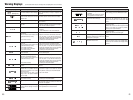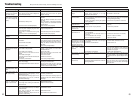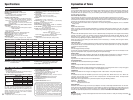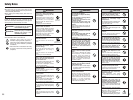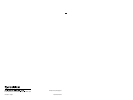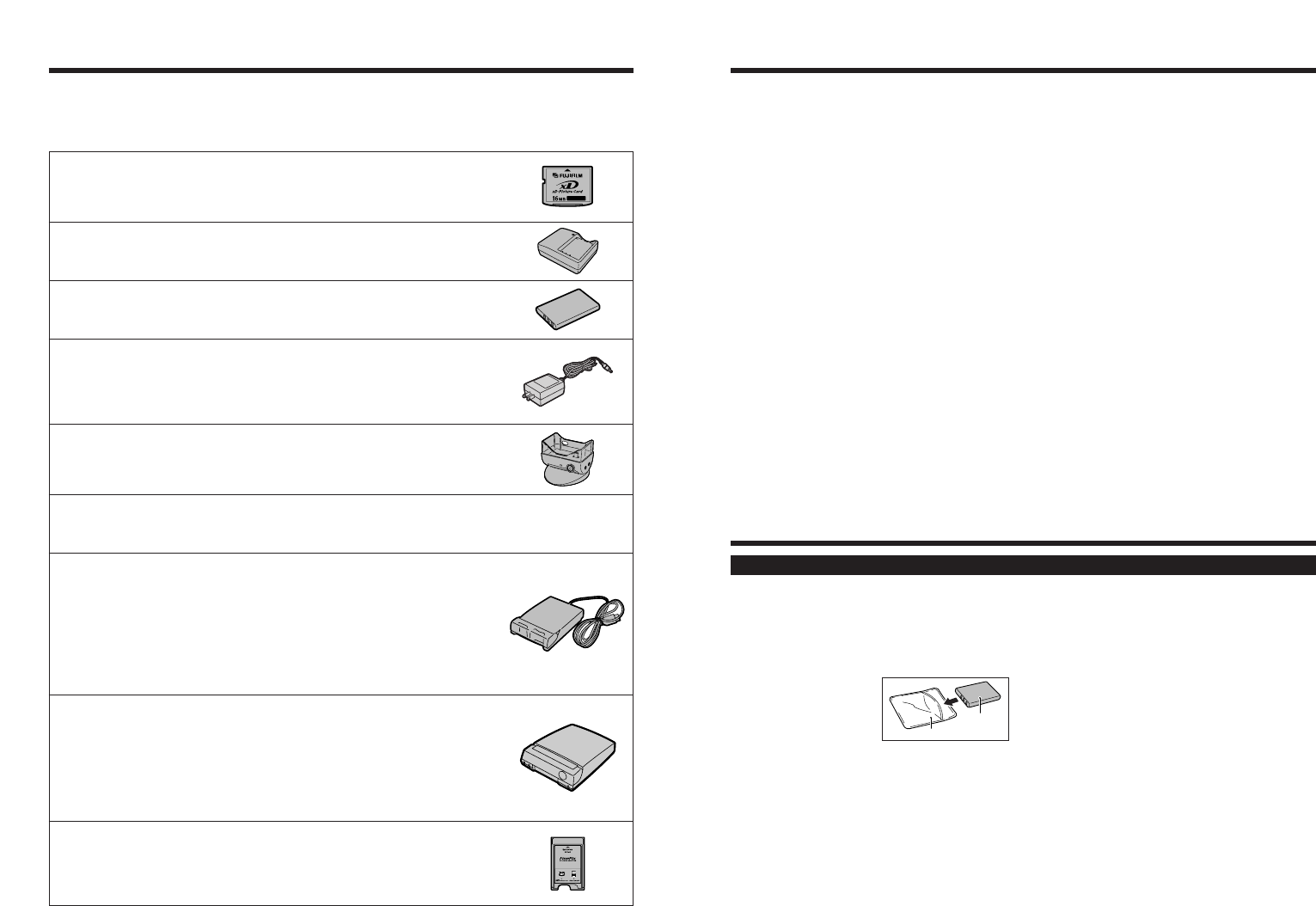
7776
Notes on Using Your Camera Correctly
eBe sure to read this information in conjunction with “Safety Notes” (➡P.86), to ensure that you
use your camera correctly.
■ Places to Avoid
Do not store or use the camera in the following types of
locations:
h In the rain or in very humid, dirty or dusty places.
hIn direct sunlight or in places subject to extreme
temperature rises, such as in a closed car in summer.
h Extremely cold places.
h Places subject to strong vibration.
h Places affected by smoke or steam.
hPlaces subject to strong magnetic fields (such as
near motors, transformers or magnets).
hIn contact with chemicals such as pesticides or next
to rubber or vinyl products for long periods of time.
■ Notes on Immersion in Water or Sand
The FinePix M603 is particularly adversely affected by
water and sand. When you are at the beach or close to
water, ensure that the camera is not exposed to water
or sand. Take care also not to place the camera on a
wet surface. Water or sand inside the camera can
cause faults that may be irreparable.
■ Notes on Condensation
If the camera is carried suddenly from a cold location
into a warm place, water droplets (condensation) may
form on the inside of the camera or on the lens. When
this occurs, switch the camera off and wait an hour
before using the camera. Condensation may also form
on the media. In this event, remove the media and wait
a short time before using it again.
■ When the Camera is Unused for Long
Periods
If you do not intend to use the camera for a long period
of time, remove the battery and the media before
storing the camera.
■ Cleaning Your Camera
hUse a blower brush to remove dust from the lens and
LCD monitor screen as these surfaces, and then
wipe lightly with a soft, dry cloth. If any soiling
remains, apply a small amount of lens cleaning liquid
to a piece of FUJIFILM lens cleaning paper and wipe
gently.
hDo not scratch hard objects against the lens and LCD
monitor screen as these surfaces are easily
damaged.
hClean the body of the camera with a soft, dry cloth.
Do not use volatile substances such as thinners,
benzine or insecticide, as these may react with
camera body and cause deformation or remove the
coating.
■ Using the Camera Overseas
When travelling overseas, do not place your camera in
the check-in baggage. Baggage handling at airports
may subject baggage to violent shocks, and the
camera may be damaged internally even when no
external damage is visible.
Notes on the Power Supply
This camera uses the Rechargeable Lithium-ion Battery
Pack NP-60. Note the points below when using the
rechargeable battery. Take particular care to read the
Safety Notes to ensure that you use the battery correctly.
✽When shipped, the NP-60 is not fully charged.
Always charge the NP-60 before using it.
h When carrying the NP-60, install it in a digital camera
or keep it in the soft case.
h When storing the NP-60,
place it inside the special
soft case provided.
■ Battery Features
h The NP-60 gradually loses its charge even when not
used. Use a NP-60 that has been charged recently
(in the last day or two) to take pictures.
h To maximize the life of the NP-60, switch the camera
off as quickly as possible when it is not being used.
h The number of available shots will be lower in cold
locations or at low temperatures. Take along a spare
fully charged NP-60.
You can also increase the amount of power
produced by putting the NP-60 in your pocket or
another warm place to heat it and then loading it into
the camera just before you take a picture.
If you are using a heating pad, take care not to place the
NP-60 directly against the pad. The camera may not
operate if you use a depleted NP-60 in cold conditions.
■ Charging the Battery
h You can charge the NP-60 using the AC Power
Adapter AC-5VS/AC-5VHS.
• The NP-60 can be charged at ambient
temperatures between 0°C and +40°C (+32°F and
+104°F). At an ambient temperature of +23°C
(+73°F), it takes approximately 3 hours to charge a
fully depleted NP-60 battery.
• You should charge the NP-60 at an ambient
temperature between +10°C and +35°C (+50°F and
+95°F). If you charge the NP-60 at a temperature
outside this range, charging takes longer because
the performance of the NP-60 is impaired.
• You cannot charge the NP-60 at temperatures of
0°C (+32°F) or below.
h You can also use the optional BC-65 Battery Charger
to charge the NP-60.
• The NP-60 can be charged using the BC-65 Battery
Charger at ambient temperatures between 0°C and
+40°C (+32°F and +104°F). At an ambient
temperature of +23°C (+73°F), it takes
approximately 2 hours to charge a fully depleted
NP-60 battery.
• You should charge the NP-60 at an ambient
temperature between +10°C and +35°C (+50°F and
+95°F). If you charge the NP-60 at a temperature
outside this range, charging takes longer because
the performance of the NP-60 is impaired.
h The NP-60 does not need to be fully discharged or
exhausted flat before being charged.
h The NP-60 may feel warm after it has been charged or
immediately after being used. This is perfectly normal.
h Do not recharge a fully charged NP-60.
Soft case
Battery
(NP-60)
Notes on Using the Battery (NP-60)
Accessories Guide
e The optional accessories (sold separately) can make taking pictures with the FinePix M603 even easier.
For information on how to attach and use the accessories, refer to the instructions provided with the
accessory used.
Visit the FUJIFILM web site for the latest information on camera accessories. http://home.fujifilm.com/products/digital/index.html
h xD-Picture Card
These are separately available xD-Picture Card cards.
Use the following xD-Picture Card:
DPC-16 (16MB)/DPC-32 (32MB)/DPC-64 (64MB)/DPC-128 (128MB)
h BC-65 Battery Charger
Quickly charges the rechargeable battery. The BC-65 reduces charging time to
approximately 2 hours (for the NP-60).
h NP-60/NP-120 Rechargeable Battery
The NP-60 is a slimline lithium-ion rechargeable battery.
The NP-120 is a high-capacity lithium-ion rechargeable battery.
h DPC-R1 Image Memory Card Reader
The DPC-R1 provides a quick and easy way to transfer images back and forth
between your PC and an image memory card (xD-Picture Card and
SmartMedia). The DPC-R1 uses the USB interface for high-speed file transfer.
h Compatible with Windows 98/98 SE, Windows Me, Windows 2000
Professional, Windows XP or iMac, Mac OS 8.6 to 9.2, Mac OS X (10.1.2 to
10.1.5) and models that support USB as standard.
h Compatible with xD-Picture Card of 16MB to 128MB, and SmartMedia of 3.3V,
4MB to 128MB.
h PictureCradle CP-FX 603
If you connect the AC power adapter and USB cable to this cradle, you can
charge the camera battery or connect the camera to your computer just by
placing the camera in the cradle.
h DPC-AD PC Card Adapter
The PC Card Adapter allows the xD-Picture Card and SmartMedia to be used as
a PC Card Standard ATA-compliant (PCMCIA 2.1) PC card (Type II).
h Compatible with xD-Picture Card of 16MB to 128MB, and SmartMedia of 3.3V,
2MB to 128MB.
h DM-R1 Image Memory Card Reader
This device provides a simple way to transfer image data in either direction
between your PC and an image memory card (SmartMedia or CompactFlash
Type II (Microdrive-compatible)).
The IEEE 1394 interface provides high-speed data transfer.
h Compatible with Windows 98 SE, Windows 2000 Professional (read-only),
iMac DV and Power Macintosh PCs with FireWire as a standard feature. Mac
OS 8.5.1 to 9.1
h SC-FX 603
This is designed to protect the camera against dirt, dust and light knocks while
you are carrying it.
h AC-5VH/AC-5VHS AC Power Adapter
Use the AC-5VH/AC-5VHS when you want to take pictures or play back images
for long periods or when the FinePix M603 is connected to a personal computer.
✽ The shape of the AC power adapter, the plug and socket outlet depend on the
country.



